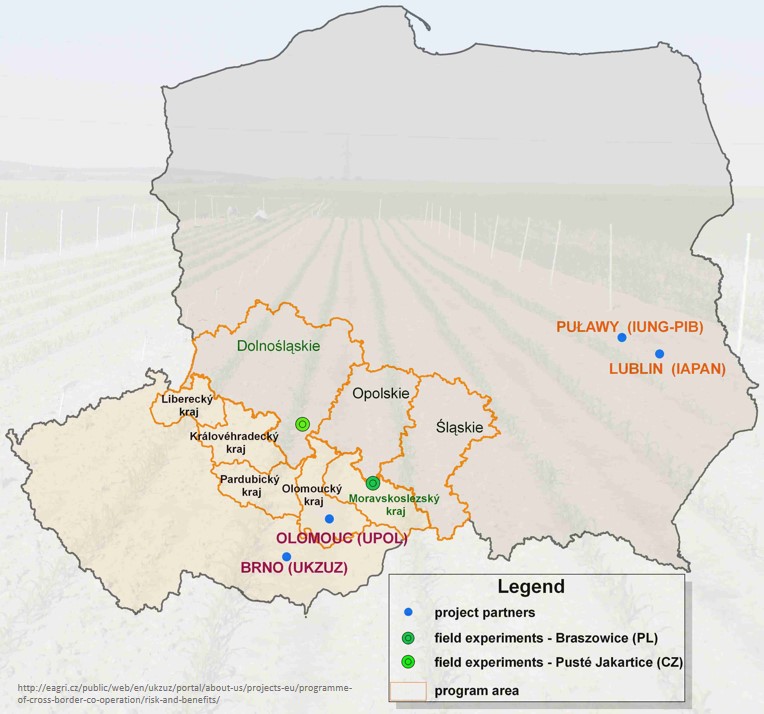
Leader: dr hab. Andrzej Bieganowski, prof. IA PAN
Team: dr hab. Małgorzata Brzezińska, prof. IA PAN; dr Jolanta Cieśla; mgr Katarzyna Jaromin-Gleń, mgr Wioleta Stelmach, mgr Magdalena Koczańska
Changes in agriculture involving advanced specialisation and improvements in crop rotation lead to reduction of supply of crop residues into soil and, consequently, a decrease in soil organic matter (OM) content. This is a disadvantageous phenomenon, as OM plays a key role in sustenance of soil fertility and quality and counteracts climate change by retention of carbon in soil (Lal et al., 2004b, Malý and Siebielec, 2015).
Exogenous organic matter (EOM) comprises organic waste from agriculture, municipal activities, and industry, e.g. plant and animal residues, sewage sludge, compost, and other organic waste. The use of EOM in agriculture is a method for organic waste recycling and a promising mode of both, increasing the content of OM in soil and replacing synthetic fertilizers (Noirot 2016). Ensuring safe fertilization with EOM requires detailed research to test the fertilizers and analyse their impact on the soil and agro-ecosystem. An important element of this research is the determination of the effect of EOM on biogeochemical processes leading to emission of greenhouse gases (CO2, CH4, and N2O) from soil into the atmosphere.

The aim of the investigations is to determine the impact of fertilization of soil with exogenous organic matter (EOM) on emission and absorption of methane (CH4). The results will facilitate assessment of the effects of fertilization with exogenous organic matter in terms of methane balance (one of the most important greenhouse gases).
The presented task complements the research conducted under a completed project “Risk and benefits of application of exogenous organic matter on soil” financed from the Czech Republic-Republic of Poland Cross-Border Cooperation Operational Programme 2007-2013.
The soil material was sampled on experimental fields the Braszowice village (Poland) and Puste Jakartice (Czech Republic) (mineral soils under maize, Zea mays L cultivation). The following fertilization variants were applied: compost - organic fertilizer from manure, liquid manure, and straw (Ag); animal meal - organic fertilizer from II and III category animal waste (Mb); industrial compost - organic fertilizer from different composted waste (Ra); digestate - produced by fermentation of residues from production of chips (Dg). The control soil (K) was only fertilized with mineral nitrogen fertilizer (100% dose, 200 kg ha-1). In the other plots, 50, 75, or 100 doses of nitrogen were applied with EOM and the other part was provided in the form of mineral fertilization. The collected soil samples were incubated in the laboratory to determine the methanotrophy (methane absorption) or methanogenesis (methane emission) potential.
In the first year of the investigations, the use of exogenous organic matter stimulated potential methanogenic and methanotrophic activity in the soil, depending on the EOM type and dose. The increase in methane production was associated to the supply of organic substrate to microorganisms. A probable cause of the stimulation of the methanotrophic activity in the EOM-fertilized soil was the substantially lower, compared to the control soil, supply of mineral nitrogen forms (NH4+ and NO3-). These compounds often strongly inhibit the methanotrophic activity of soils.
We are currently studying the effect of repeated EOM application to test whether such a practice changes soil processes related to greenhouse gas emission and sink. Moreover, we are planning to correlate our results with other physical, chemical and biological soil properties measured by scientists involved in the project.
References
- Malý S., Siebielec G. (2015) Badania egzogennej materii organicznej w celu bezpiecznego stosowania do gleby. Central Institute for Supervising and Testing in Agriculture, Brno, Czech Republic, str. 1-143.
- Lal R. (2004) Soil carbon sequestration impacts on global climate change and food security. Science 304: 1623-1627.
- Noirot-Cosson P.E., Vaudour E., Gilliot J.M., Gabrielle B., Houot S. (2016) Modelling the long-term effect of urban waste compost applications on carbon and nitrogen dynamics in temperate cropland. Soil Biol. Biochem. 94: 138-153.
